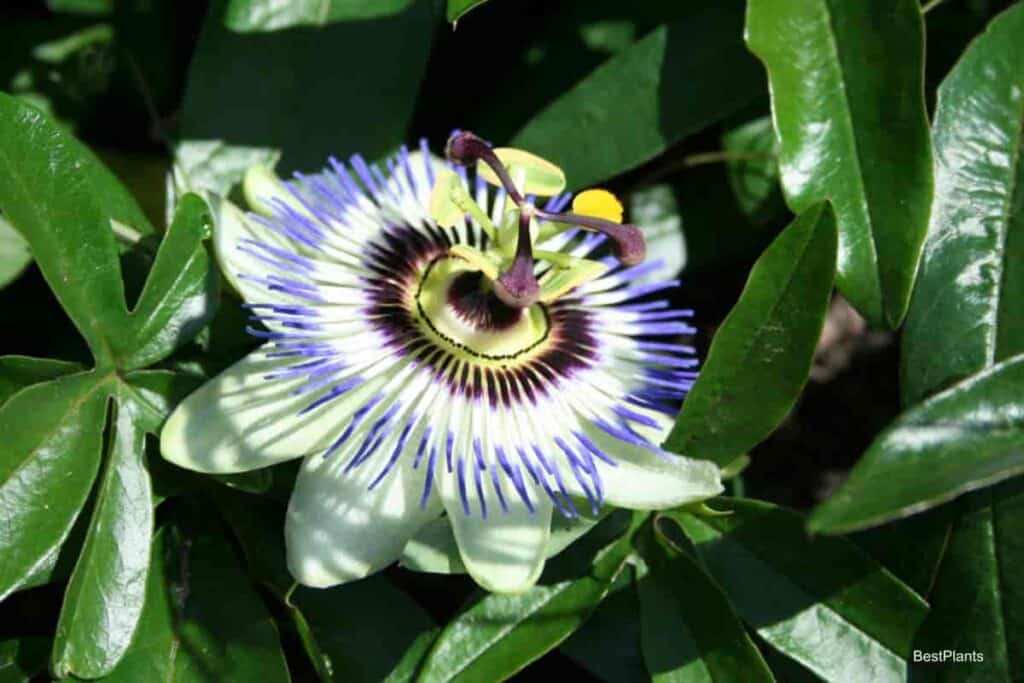The passionflower is a delicate, perennial flowering vine known for its deep-lobbed flower.
Its Latin name is Passiflora incarnata, pronounced as [pass-iff-FLOR-uh] [in-kar-NAH-tuh].

The Passifloraceae [pas-ih-flor-AY-see-ee] family is native to the Americas, thriving in tropical regions.
Passionflowers can also be referred to as:
- Passiflora (botanical name)
- Passion vines
- Apricot Vine
- Maypop
- Stinking Passionflower
- Bush passion fruit
- Wild water lemon
Did you know that passiflora has biblical roots behind its naming?
It was thought that the 5 petals and 5 sepals represented the 10 apostles.
Note: Other species in the family are the following:
- Passiflora caerulea [see-ROO-lee-uh]
- Passiflora coccinea [kok-SIN-ee-uh]
They all have very similar looks but different colored flowers.
The passion fruit plant, Passiflora edulis [ED-yew-liss], is also a passiflora!
Tips And Tricks For Passion Flower Vine Care
Size And Growth
Passifloras are slow to germinate but quick to grow.
Depending on the species, it can range from 6’ to 30’ feet as a whole plant.
The flowers alone can be around 3” inches long.
The fruits can grow up to 2” inches, and they are a warm yellow when ripe.
Passifloras need support or fencing to grow into shape.
Flowering And Fragrance
When we said that the passiflora was commonly called the “stinking passion flower,” we weren’t kidding!
Passifloras have a strong odor that might be disorienting to some people.
Passiflora flowers are only fully blooming for one day.
If they aren’t fertilized, they drop on their own.
Light And Temperature
Passion vines can grow between climate zones 6 and 11.
They lean towards tropical, medium to high humidity regions.
Indoor passifloras need indirect light for a few hours every day and to be kept out of strong air currents.
Outdoor ones need partial shade.
If the climate leans towards hot, give it more shade.
In colder weather, expose the vine to at least 4 hours of sunlight.
In extremely cold temperatures (below 55° degrees Fahrenheit), passiflora may get frostbite or go through stunted growth phases.
So, if you live in colder regions, you might want to move it indoors for the winter.
Watering And Feeding
For new vines, add water generously.
Later on, watering once or twice every week is enough.
In containers, passifloras need higher feed than in open soil.
We recommend fertilizing in winter before the growing season begins.
For fertilizers, pick any kind with equal parts, such as:
- Potassium
- Nitrogen
- Phosphorus.
Soil And Transplanting
Passifloras are very forgiving when it comes to soil.
They can tolerate neutral to acidic soil, anywhere between 6.1 and 7.5 pH.
The soil needs to be moist but with adequate draining.
Other than that, any non-saline soil will do.
Grooming And Maintenance
Passion vines are generally low maintenance.
To make sure they’re healthy and thriving, though, you might want to consider mulching and pruning.
Mulching is a simple method of protecting the soil by adding a layer of “mulch” or straw.
This helps the soil retain watering and feeding power.
Pruning, on the other hand, is the selective removal of plant parts to enhance growth.
It’s recommended to prune your vines during late winter in preparation for spring growth.
How To Propagate Passion Flower Vine?
Passifloras are considered invasive under the right conditions.
So, you shouldn’t have trouble propagating them.
They can either propagate from cuttings or seeds.
For stem cuttings, make sure that they were taken earlier in the season before blooming and that they ate between 6” to 8” inches.
If you want to harvest seeds yourself, here’s a quick walk-through:
- Pick ripe fruits only and open them carefully to extract the seeds.
- Wash the intact seeds and let them dry.
- Wait a while to see sprouting. It may take 10 to 20 days. To speed up this process, you can wrap the container in plastic to lock the moisture in and heat the soil.
- For the very first days, keep the plant away from direct sunlight. Instead, we recommend using a plant-specific light.
- Once the sprout is visible, you can take it outdoors. Keep in mind that this isn’t a viable option in extremely cold regions.
Common Passion Flower Vine Pests Or Diseases
Passiflora leaves are hosts to many larvae, such as:
- Crimson patch
- Zebra Longwing
- Mexican butterfly.
Tropical weather increases the vine’s chances of getting pests, such as:
- Spider mites
- Whiteflies
It is less common for a vine to get infected with fungal leaf spotting or root rot.
These need anti-fungal intervention.
Suggested Passion Flower Vine Uses
Passifloras are very pretty and make great garden flowers.
We recommend limiting their ornamental use to the outdoors to avoid any scent issues.
In some regions, passifloras are juiced, mainly the Passiflora edulis (the passion fruit plant.) In fact, “edulis” is Latin for “edible.”
On a final note, eating and drinking passifloras isn’t a new thing.
Native Americans used passion vines to make medicinal teas.
If you just want to see (and smell!) the vines before getting committed, you can find them at many wildlife displays, like the Lady Bird Johnson Wildflower Center.